50 years of Nikon F-mount – Nikkor-S 5.8 cm f/1.4 vs. Nikkor AF-S 50 mm f/1.4G
3. Build quality
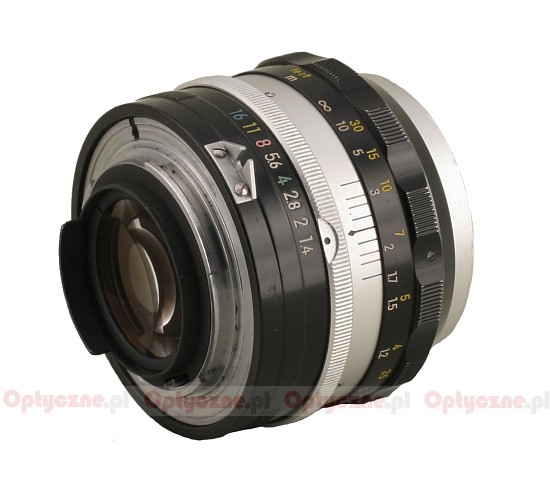 |
The manual focusing ring is quite big and convenient. Apart from a small corrugation it also has hollows for fingers, which is supposed to make the work more convenient and easier. After nearly 50 years from leaving the factory it works smoothly, with maybe too much slack. Our copy has a distance scale expressed both in meters and feet. You can also find ones with just feet or just meters, though.
Please Support UsIf you enjoy our reviews and articles, and you want us to continue our work please, support our website by donating through PayPal. The funds are going to be used for paying our editorial team, renting servers, and equipping our testing studio; only that way we will be able to continue providing you interesting content for free. |
- - - - - - - - - - - - - - - - - - - - - - - - - - - - - - - - - - - - - - - - - - - - - - - -
The movement of this ring causes the movement of the whole optical system, so during focusing the lenses inside don’t change their mutual positions, and the focal length remains the same.
The aperture ring works with appropriate resistance. It allows us to change the parameter with 1 EV steps. In it, there are forks which, in older F bodies, informed the body of the aperture used. Between the two rings there’s a rim with a depth of field scale. The colors of marks correspond to colors of the aperture values, which can be changed from f/1.4 to f/16
By virtue of metal body, Nikkor-S is the heaviest lens of 50s of f/1.4 speed manufactured by Nikon. However, it’s not the biggest, Nikkor AF-S 50 mm f/1.4 is more barrel-shaped. You can see that clearly in this table and in the pictures below.
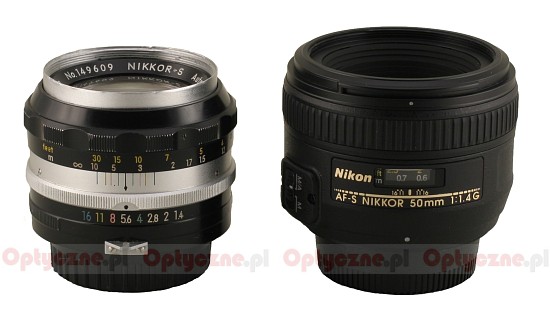 |
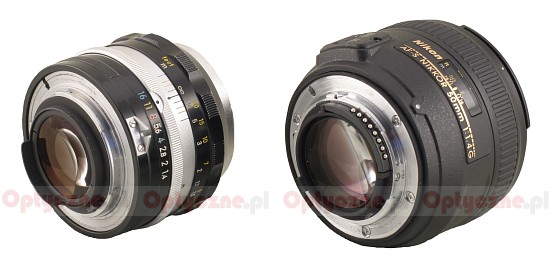 |
As we mentioned at the beginning, you can find contradictory information on the optical construction of the discussed Nikkor. We’ve managed to find a reliable schema signed by Nikon, which unambiguously states that we’re dealing with 7 elements set in 6 groups. There’s a diaphragm of 6 blades which closes to f/16, to complete the picture.
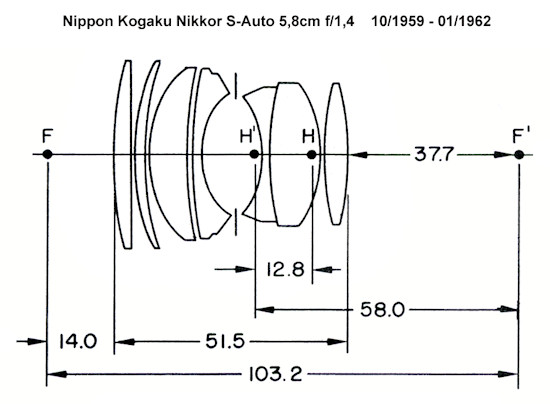 |
As you can see, in its time Nikkor-S was quite a complicated construction. It’s worth to add that the modern AF-S 1.4/50 model gained only one more lens. The diaphragm was enriched with a more rounded shape and as many as nine blades. The front lens of the new Nikkor appears to be smaller and it’s further into the body. The comparison of the two lenses, in terms of vignetting and working against bright light, should be interesting, then.
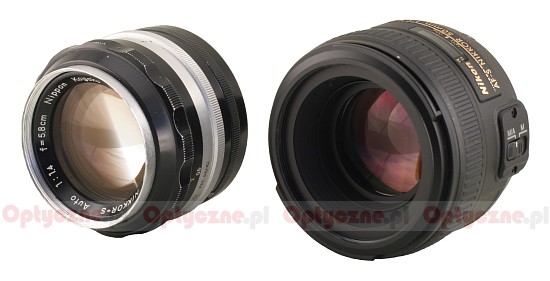 |
The buyer received both caps and a metal lens hood in the set. The front cap had a tasteful chrome hoop marked with an L38 symbol, a 52 mm diameter, a Nikon Japan sign and two metal buttons for releasing it from the lens.
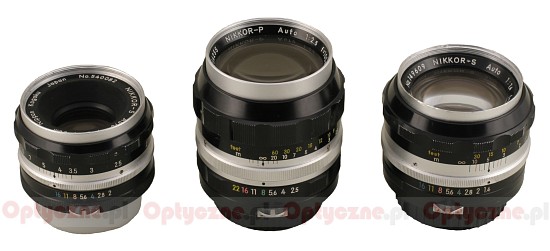 |
To end this chapter there’s also one more issue to explain. Nikkor-S 5.8 cm f/1.4 belongs to the group of the oldest F-mount lenses, so it belongs to the non-AI group, lenses with no mechanism for the cooperation of the aperture ring and the light meter, called AI – Automatic Indexing and introduced in 1977. Lenses manufactured after this date had a fastening on the aperture ring, whose position depended on the maximum aperture. Early AI bodies were connected to the fastening by a small lever which, when using non-AI lenses, could be lifted up. Currently produced bodies don’t have the capability of lifting this lever, so there was a doubt if we could mount old lenses on such a new body as D3x. It turned out that the lever is so thin that the lens’ body slides underneath it and so it stays still after mounting the lens, unlike AI lenses which move it by a value depending on the maximum aperture. It carries with it a problem. Even if the camera body is capable of writing information on a used non-CPU lens, strange value land in EXIF. While the focal length is recorded accurately, the aperture isn’t quite. In EXIF there’s often the maximum aperture of the lens given, no matter what aperture was actually used. Still, sometimes the camera body just went haywire and recorded random aperture values.






